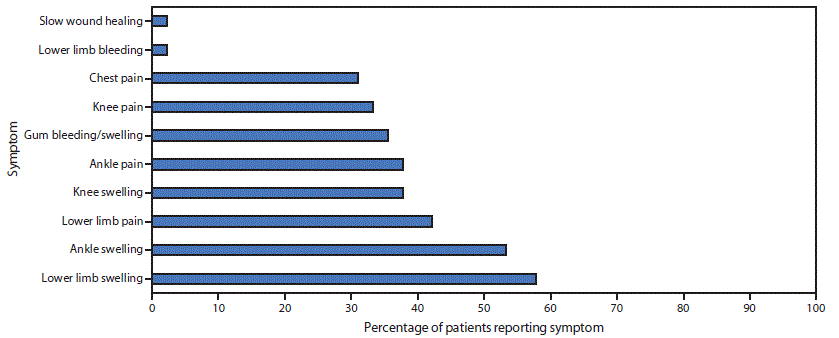Archive for the ‘Scurvy’ Category
Scurvy Outbreak Among South Sudanese Adolescents and Young Men
Monday, January 28th, 2019
Ververs M, Muriithi JW, Burton A, Burton JW, Lawi AO. Scurvy Outbreak Among South Sudanese Adolescents and Young Men — Kakuma Refugee Camp, Kenya, 2017–2018. MMWR Morb Mortal Wkly Rep 2019;68:72–75. DOI: http://dx.doi.org/10.15585/mmwr.mm6803a4.\
“…..Severe vitamin C deficiency causes scurvy, a disease that is mainly associated with long sea voyages and naval expeditions until the 19th century. Scurvy manifests itself 2-3 months after consuming a diet lacking of vitamin c; it is characterized by multiple haemorrhages and, left untreated, is fatal. In the past decade, several refugee populations that were wholly dependent on food aid have developed scurvy…..”
“……A disease caused by prolonged severe dietary deficiency of ascorbic acid, in which the breakdown of intercellular cement substances leads to capillary haemorrhages and defective growth of fibroblasts, osteoblasts, and odontoblasts results in impaired synthesis of collagen, osteoid, and dentine; it is characterized by haemorrhagic gingivitis affecting especially the interdental papillae (in the absence of teeth, the gums are normal), subperiosteal haemorrhages, bone lesions (including the corner fraction sign, a ground-glass appearance, and trabecular atrophy) seen on radiography, perifollicular haemorrhages, and frequently petechial haemorrhages (especially on the feet). Sudden death may occur as a result of cerebral or myocardial haemorrhage. Megaloblastic anaemia, usually due to concomitant iron and/or folate deficiency, is usual. The early manifestations include weakness, lethargy, myalgia, and arthralgia. In the infantile form (in which onset usually occurs in the second 6 months of life), gingival involvement is minimal and the infant assumes a ‘frog-like’ position and does not move its legs (owing to the intense pain of subperiosteal haemorrhages). In the adult form there are intraarticular and intramuscular haemorrhages, and osteoporosis may occur. The disorder may occur in infants born to mothers who are consuming large doses of ascorbic acid, and in adults following the abrupt discontinuation of large supplemental doses (despite relatively normal dietary intake of ascorbic acid).
Source: International nomenclature of diseases. Vol. IV Metabolic, nutritional, and endocrine disorders. Geneva, World Health Organization, 1991, p. 283……”
WHO-Scurvy Primer: Document
“……Manifest scurvy in adults is preceded by a period of latent scurvy whose early symptoms include lassitude, weakness and irritability; vague, dull aching pains in the muscles or joints of the legs and feet; and weight loss. Shortness of breath may also occur and the skin can become dry and rough. The principal signs and symptoms of manifest scurvy in adults consist of follicular hyperkeratosis, haemorrhagic manifestations, swollen joints, swollen bleeding gums, and peripheral oedema (Hodges et al., 1971). Anaemia of a variable degree occurs with scurvy in a certain percentage of adults and infants, which is considered to be due in part to undernutrition and intercurrent infection. However, it is due chiefly to the effect of vitamin C on blood formation, folic acid metabolism, and bleeding.
In children the syndrome is called Moeller-Barlow disease, and is seen in non-breast-fed infants usually at about 5-6 months of age when maternally derived stores of vitamin C have been exhausted. No single symptom predominates, but the majority of infants with scurvy eventually show signs of irritability, tenderness of the legs, and pseudo paralysis, usually involving the lower extremities. The “pithed-frog” position—legs flexed at the knees and hips partially flexed—is assumed by approximately half the sufferers. Involvement of the costochondral junctions is very common, and costochondral beading is found in 80% of infants with scurvy. Haemorrhage around erupting teeth is consistently present. Petechial haemorrhages in the skin may occur (10 -15% of infants with scurvy). Left untreated, scurvy in any age group can lead to death……”

